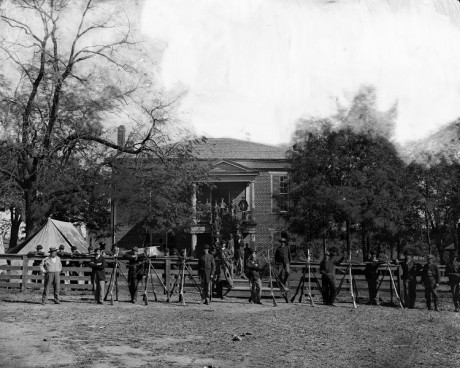The Civil War ends again this week. The citizens of Appomattox County will be inconvenienced at least through April 12 by all manner of tableaus, tours and demos of events surrounding the surrender of the Army of Northern Virginia to the Army of the Potomac in 1865.
I’m surprised by how little interest was evidenced generally in the sesquicentennial of The Late Unpleasantness, but my appraisal may be tempered by having witnessed the centennial in the 1960s. In grade school at that time, just as Governor George Wallace was setting himself up as an heir to Confederate ambitions, I remember field trips: to Montgomery to see the first rebel White House and to Birmingham’s Arlington House, where I bought a cannon replica for a whopping $1.25 oblivious to the fact that no actual artillery had ever been set up on Cotton Avenue Southwest unless visiting Yankees rolled it in.
The last of the men who fought in the Civil War had died not too long before the centennial began in 1960, and the movie Gone With the Wind was not even a quarter-century old, so, yes, there was a certain freshness in that commemoration. Newspapers carried daily features on events 100 years before. Newsmagazines carried photos of a new cadre of celebrants called “re-enactors,” who made the faithful depiction of grisly combat into a weekend hobby for the whole family. There was even a Civil War Centennial Commission (chaired by Ulysses S. Grant III) to lend structure to the national pageant.
That pageant was complicated by political realities still festering a century after the Civil War. Even as portraits of Robert E. Lee and Stonewall Jackson were dusted off and displayed, pictures of new rebels such as Martin Luther King Jr. and Malcolm X were being seen regularly in the news. The Commission found it hard even to organize opening ceremonies in Charleston, S.C., in 1961 because local segregation ordinances made it difficult for black visitors to take part. The Confederate battle flag was waved frequently in Birmingham, but less often to mark a historical observance than to rally white supremacists.
One of the most interesting analyses of the South 150 years after Appomattox has been written by Tracy Thompson for the online magazine The Bitter Southerner, and its title plainly states the premise “Dixie Is Dead.”
Thompson has also written an ambitious book, The New Mind of the South, addressing author W.J. Cash’s landmark 1941 volume, The Mind of the South. In both book and essay she describes big differences between the South that was and the South that is.
“Let’s face it,” she writes, “’Dixie’ has become one of those empty words whose only purpose is to convey stereotypes.”
Back when Cash (interestingly born in the mythical Frank Underwood’s hometown of Gaffney, S.C.) wrote his analysis, he could get away with calling the South “another land, sharply differentiated from the rest of the American nation…exhibiting within itself a remarkable homogeneity.” The South had not recovered economically from the Civil War and, industrial centers such as Birmingham excepted, was throughout the states of the old Confederacy still agrarian and struggling. The challenges to those residents were common as were their interests.
World War II changed the South forever. The nationwide effort to defeat the Axis powers unified the country in a powerful new way. Urbanization became a sort of economic kudzu covering the region. Economic opportunity led to social freedom for the South’s non-white population. The eventual result was what Thompson sees as a tribalization of the South: “There’s a vast chasm between a typical white voter in, say, Baxter County, Ark., and his white counterpart in some in-town liberal enclave in Austin or Durham. Chances are that each will find the other culturally incomprehensible — and both of them will, in their own way, be culturally alien to the black voter in Coahoma County, Miss.”
She’s got a point. We in the South don’t understand each other the way our ancestors would have. I don’t mean necessarily the cultural differences between states; just look at the pitiable Comments section under any story with a political angle on al.com to ascertain how toxically indifferent we have become to each other’s point of view. The Solid South ain’t no more.
Thompson goes on to say that any quest for a collective Southern identity may by now be quixotic, but Southerners will always have the past at least in common: “That’s what Southerners know, however imperfectly we sometimes grasp it. History happened to us. It either happened to us personally, as some who were on the Edmund Pettus Bridge that day in Selma can attest, or to our direct ancestors.”
My great-grandfather, E.R. Murray, was up in Appomattox County 150 years ago this week. He didn’t get into the war until he turned 18 in 1864, and his heroic part in the historic conflict was to drive the front team of six horses for Caisson No. 4 in Company A of the First Confederate Field Artillery. It is not altogether clear how a young drover from backwoods North Carolina wound up at the epicenter of the end, but according to his version, faithfully transcribed by my kinswoman Clara Copeland, E.R. did indeed watch the soldiers stack their guns, roll up their flags and turn them over to the victors.
But history didn’t stop there.
Old E.R. lived to see indoor plumbing, electric lights, automobiles and innumerable transformations of society that young E.R. could never have imagined. We’re like him in this way: the world in which we live now is dramatically different than the one in which we started. Our success is predicated on how well we adapt.
If the South is looking for a new cultural identity, perhaps it should be based, for a change, not on how tenaciously we cling to the old, but how willing we are to acknowledge — and even accept — the new.






